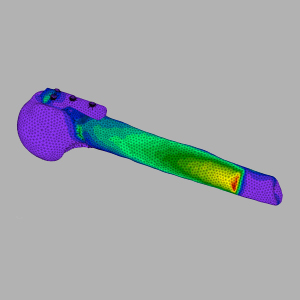Optimisation of implant position in cemented femur in Total Hip Replacement
Total hip replacement (THR) is one of the most common and effective surgical procedures performed worldwide with the purpose of improving the quality of life of patients suffering from hip disorders. There are two major types of artificial hip replacements : cemented and uncemented. This paper presents finite element approach to measure micromotion along the stem /cement and cement/ bone interface. A response surface model (RSM) was created and used to determine the best implant position for lowest value of micromotion. In this study finite element model of femur was created from 3D CT scan data using ImageSim software from VOLMO LTD (UK).
Surface model of femur in STL format was exported into CAE environment ( TSV Pre ) where femur resection , implant positioning and alignment was done. The final assembled model of bone, cement and implant was used as the base model for creating new models. The loading and boundary condition have been applied for walking condition.










